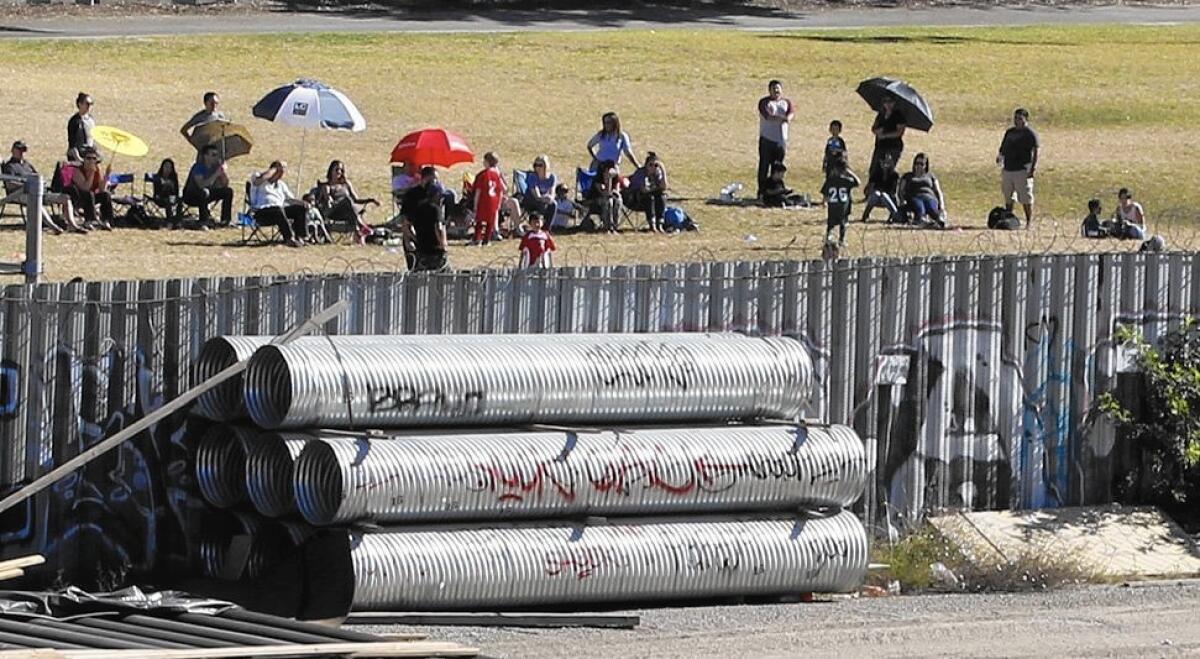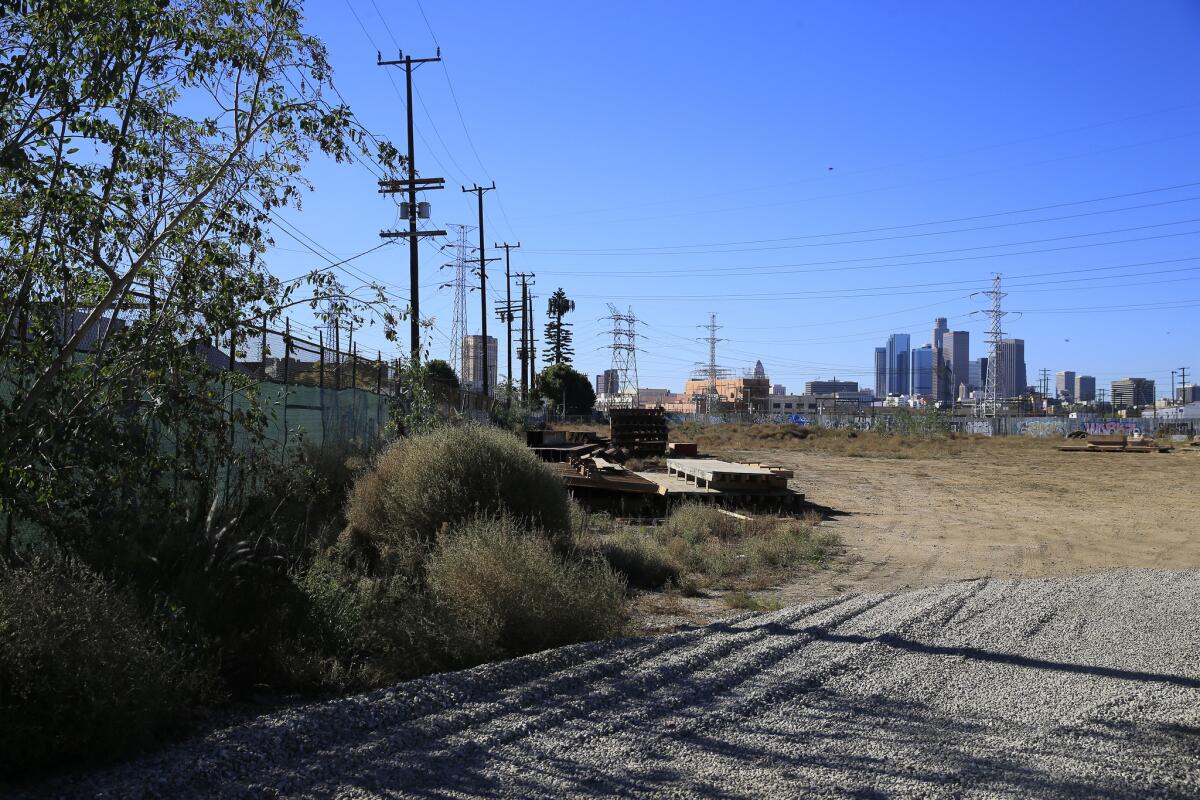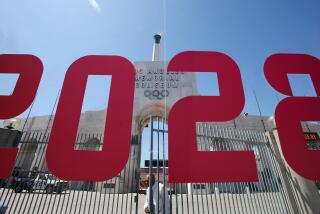First & Spring: Park project could offer lessons for L.A. Olympic bid

Organizers of L.A.’s push to host the 2024 Summer Olympics have been looking at an Eastside rail yard as a possible location for a massive athletes’ village — one capable of housing 17,000 people during the Games.
City budget analysts say they worry about the cost and complexity of redeveloping such a heavily industrial parcel, which is next to the Los Angeles River.
The skepticism over the rail property, known as Piggyback Yard, is also being fueled by the city’s experience with another piece of industrial land in Lincoln Heights nearly a mile upstream. On nearby Albion Street, city officials have so far spent six years converting an old dairy distribution facility into a parkland.
Albion Riverside Park is set to open in December 2018 at a cost of nearly $38 million, public works officials say. Councilman Mitch O’Farrell, who sits on the council’s Ad Hoc Committee on the 2024 Summer Olympics, said the project shows how costly and time-consuming it can be to buy and clean up industrial land next to the river — even when things mostly go right.

The Albion Street park site, seen above last month, is 1/20th the size of Piggyback Yard.
Albion Riverside Park offers “an example of what we would be up against” at Piggyback Yard, O’Farrell said. “Piggyback has unknown amounts of contamination from over 100 years of being a Union Pacific rail yard. Plus it’s 125 acres, give or take, so the scale is much larger.”
The Albion dairy site has much in common with Piggyback Yard. Both are seen as pivotal to Mayor Eric Garcetti’s effort to restore and revitalize an 11-mile stretch of the L.A. River between Glendale and downtown. Both have been identified as key locations for new, environmentally friendly features to clean up stormwater that washes into the nearby waterway. And both have been home to decades of industrial activity that typically requires major soil cleanup.
O’Farrell warns that the cost of acquiring the rail yard, cleaning the soil and building an Olympic Village could reach upward of $2 billion — double the price first floated by L.A. Olympic organizers in bidding documents this year.
If L.A. wins the Games in 2017, Olympic organizers would have about seven years to convert Piggyback Yard into a combination of green space, water cleanup projects and thousands of residences, which would be used first by athletes and then sold or rented to the public. That timetable would be shorter than the one used for Albion park, which is 1/20th the size of Piggyback Yard.
Organizers with the LA 2024 committee say Piggyback Yard is just one of roughly two dozen sites being considered for an Olympic Village. Nevertheless, they continue to describe the rail yard as “an attractive possibility” for an athletes’ facility.
LA 2024 spokesman Jeff Millman said redevelopment of Piggyback Yard could revitalize a key stretch of riverbed while providing the Eastside with around 5,000 new homes once the Games are over. He also downplayed the similarities between the Albion site and the Piggyback rail yard, noting that real estate developers, not government, would head up construction of a village.
“Each real estate transaction is unique and the prices will vary,” he said in an email. “Unlike Albion, the Olympic Village is envisioned as a private development, so the costs would be offset by the value of the market rate housing, which would be the legacy use of the village after the Games.”
We won’t know the exact costs of remediating Piggyback Yard until additional testing is performed on the parcel.
— Connie Llanos, a spokeswoman for Mayor Eric Garcetti
Albion Riverside Park was conceived a decade ago as a way to add much-needed park space to the working-class neighborhood of Lincoln Heights. When completed, the project would be adjacent to the existing Downey Recreation Center, expanding the total parkland from three acres to more than nine while adding basketball courts, playground areas and walking paths. Landscaping features, funded by a 2004 bond measure, would allow stormwater to percolate into the ground instead of immediately washing into the river.
The city was fortunate to have a willing seller, and negotiations were viewed by both sides as amicable. But over the previous century, the property had been home to an array of industrial uses: welding areas, metal pipe manufacturing and warehouses operated by Ross Swiss Dairies.
City officials knew that a portion of soil was laced with contaminants, and budgeted accordingly. Once demolition and cleanup were underway, they found even larger amounts of lead, petroleum hydrocarbons and semi-volatile organic compounds than previously expected.
In some locations, construction crews had to excavate as deep as 18 feet. Cleanup lasted 20 months, with workers removing 6,000 cubic yards of soil and importing nearly twice as much fresh soil. Demolition and cleanup costs reached $6.2 million, up from the original budget of nearly $4 million, city officials said. The price increased, in part, because city officials were not able to test some of the soil until warehouse foundations were ripped out.
Garcetti spokeswoman Connie Llanos described Piggyback Yard as a “a great option” that’s “uniquely suited” for the Olympic Village project. But she noted that both city officials and Olympic organizers will need to make sure any site is financially feasible.
“We won’t know the exact costs of remediating Piggyback Yard until additional testing is performed on the parcel,” Llanos added in a statement.
Meanwhile, other challenges at Piggyback Yard go well beyond the ones confronted at the Albion site.
At Albion, the property owner did not ask for their operations to be moved. At the rail yard, Union Pacific executives have signaled that any purchase would need to include relocation of its massive cargo-handling operation. The company also has said in correspondence that it is not looking to sell.
O’Farrell, who represents neighborhoods from Echo Park to Hollywood, said he wants to hear all the facts about Piggyback before taking a position on it as an Olympic site. But he said his “instincts” tell him the rail yard is not the spot for the 2024 Games.
Other properties in Los Angeles, he said, “could also house the Olympic Village, where we might actually have a willing seller, where we may not have any soil contamination, and [where] it may not require a complete relocation of an existing company or business.”
More to Read
Start your day right
Sign up for Essential California for news, features and recommendations from the L.A. Times and beyond in your inbox six days a week.
You may occasionally receive promotional content from the Los Angeles Times.







